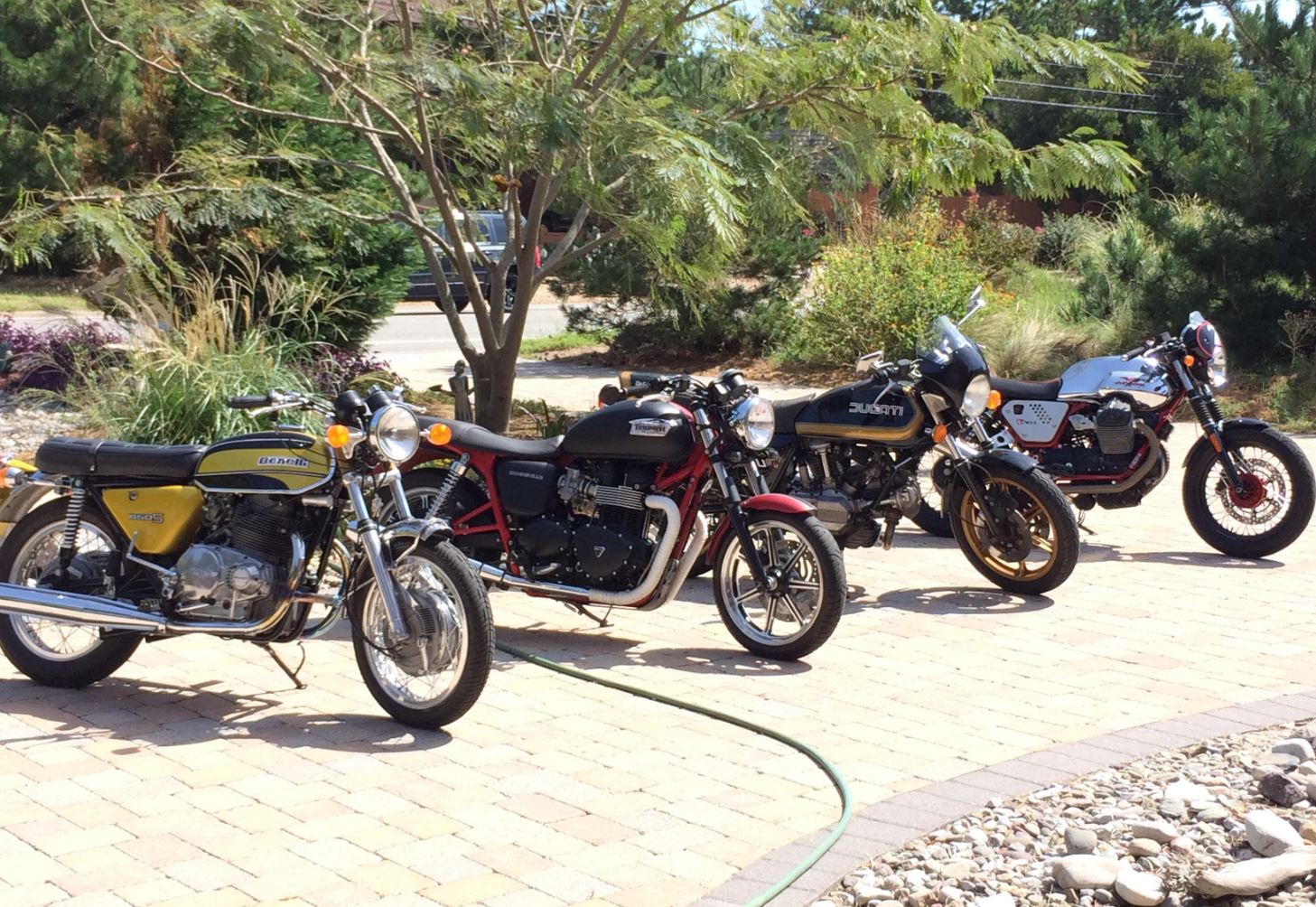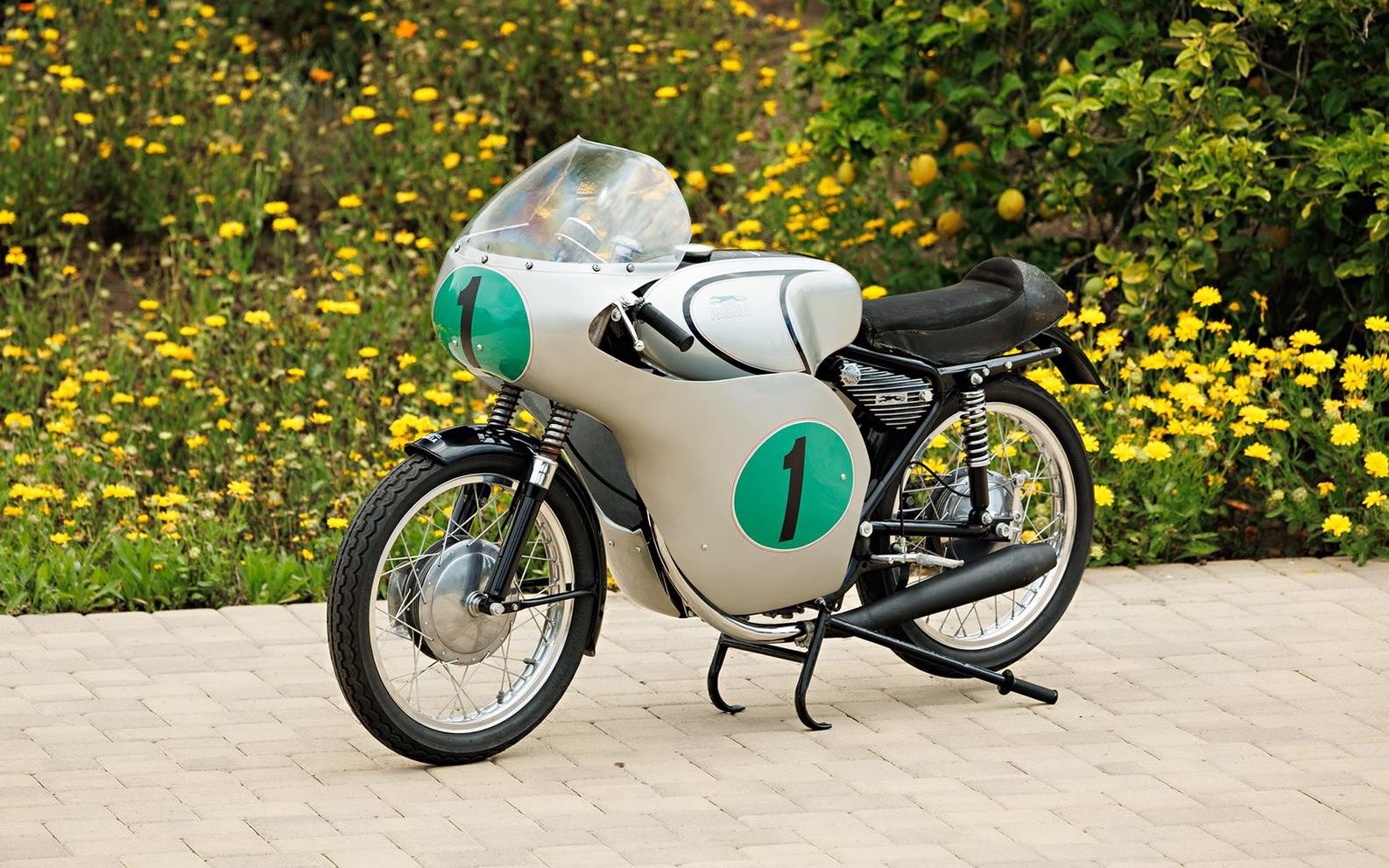A buddy named Larry F. reached out to me a couple of weeks ago saying that he was going to be at Monterey for the annual Car Week and he was hoping to meet up. Unfortunately, I couldn’t make it up this year but he was kind enough to share a few photos from his trip for anyone else that missed it.
Larry’s an east coaster who has made Car Week an annual vacation with his family. He’s also got excellent taste in motorcycles:
Without further ado, here’s my favorite finds from Larry!
While the focus of this post is going to be motorcycles, there’s obviously a bunch of incredible cars that show up for the event so I’ll highlight one. There’s lot of multi-million dollar exotica but I was particularly entertained by this prototype for a Porsche 914-6 coupe Larry spotted at Concours for a Cause as our old Service Manager Sandro recently came by the shop in a 914-6 himself. This was on display courtesy the Malamut Auto Museum, who say that it was designed by Jacques Cooper and built by the French coachbuilder Heuliez. It was to be a “more refined, luxury version of the 914” but Porsche was already working with Karmann and did not want any conflicts with coach builders. Check out the little model on the roof!
Alright, now let’s get to the bikes. Gooding & Company had three motorcycles at their Pebble Beach Auction, all of which Larry snagged in this one photo. Interestingly, they were all sold with No Reserve.
The 1971 MV Agusta 750 Sport sold for $120,000, quite a bit lower than the estimate of $160k-$200k (but that estimate seems quite high). It had a great ownership history and was claimed to be one of just 56 examples built in ’71.
The 1948 Ducati Cucciolo T2 Turismo sold for $3,500. That was also quite lower than the estimate of $8,000-$12,000 but again, that estimate seems really high.
Lastly, this Parilla 250 Grand Sport (estimate of $30,000-$50,000) was passed on. I do not know why, though it was much later than the other two in the auction so maybe the seller or the auction house was concerned about how the other bikes did? Who knows, but it’s a beautiful motorcycle:
Out and about on the streets was a bike I’ve seen before – a 1970 Aermacchi 350SS customized by Marc Crocetti, someone we regularly see on our Sunday rides.
Have you seen Marc’s bikes before? Here’s a video I filmed of him discussing his Crocetti Speciale 1971 Triumph Daytona at the 2017 Quail Motorcycle Gathering:
Another Crocetti custom was this Ducati/Cagiva Alazzurra 650-powered machine (note how Marc has “71” on his builds):
Other street finds included Bobby Weindorf’s Guzzi V7s and The Fuzz.
Most of Larry’s finds were at the Concours Carmel, and I couldn’t believe how many classic Guzzis were at this event:
1934 Moto Guzzi GT17 – Guzzi’s first military machine produced at Mandello del Lario, though this is obviously a civilian version (or was converted after duty).
1939 Moto Guzzi Egretta – produced for just two years, the Egretta was a stopgap bike that bridged two generations of Guzzis. Only 784 were ever built between ’39 and ’40, and the Egretta was the top of the line bike at the time, reflected by the smattering of chrome and generally better finish quality than the lower “Ardetta”. The bike featured a 250cc single cylinder engine, 3-speed transmission (with hand controls), fishtail exhaust, coil ignition, and no rear suspension. Simply put, it’s one of the rarest pre-war Guzzis ever made.
1948 Moto Guzzi MotoLeggera 65 – also known as the Guzzino, this was the first bike Guzzi built after WWII and was designed to provide cheap transport for Italians. The Guzzino was rather popular – approximately 72,000 were built between 1946 and 1954. The drivetrain included a 65cc 2-stroke engine paired with a 3-speed transmission. It weighed less than 100 pounds dry and the 2 horsepower from the engine was good enough for a top speed of about 30 miles per hour.
1951 Moto Guzzi Falcone Sport – built between 1950 and 1963, the design of the Falcone is impressively similar to the first production Guzzi from back in 1921. The 499cc single produced 23 horsepower, good for a top speed of about 85 miles per hour.
Moto Rumi Sport – Rumi was founded after WWII to fill the demand for cheap transportation (like with the above MotoLeggera), though they shifted away from bikes by the late 50s due to a large military contract and stopped making motorcycles in the early 60s. I’ve never encountered a Rumi Sport before, but here’s a great profile on Motorcycle Classics if you want to learn more.
1951 MV Agusta CSL 125. CSL stood for C Super Lusso, or Super Luxury. This was one of MV’s first scooters – based on the year of production you can probably guess it was also a “cheap transport for Italians after WWII” creation. The 123cc 2-stroke engine produced 5 horsepower, MV built roughly 2,500 of them.
There were a couple of gorgeous race bikes but I wasn’t able to identify the Benelli. Do any of you know what it is?
I was at least familiar with the FB Mondial, because I’ve seen it before – it won Best of Show at the 2015 Quail Motorcycle Gathering. This is a 1957 Mondial 250cc DOHC Grand Prix racer – it finished 2nd overall and won the ’57 Italian Championship while being piloted by Tarquinio Provini. This was the last year that GP racing allowed dustbin fairings, something we briefly mentioned with a custom Moto Guzzi V7 featured earlier this week.
1958 MV Agusta 175 CSS Squalo – Squalo is Italian for Shark, and it has a 175cc engine that produced approximately 16 horsepower. The CSS seems to be a race bike available for privateer efforts, and while it was originally developed to compete in Italian Formula racing, it ended up dominating 200cc classes all over Europe. When new, they cost more than a Manx Norton. When you bought these bikes from the factory, they came as a single cam, but MV offered an optional twin cam version that could be retrofitted on – bikes that were so equipped were called Bialberos.
1955 MV Agusta 175 CSS Disco Volante – Disco Volante is Italian for Flying Saucer, an affectionate nickname due to the shape of the tank. The DV had a 172cc engine that produced 14 horsepower, enough to get the 246 pound (dry) bike up to 84 miles per hour. For more information on the Flying Saucer, check out this write-up from Motorcycle Classics.
1962 Ducati 200 Elite – while MV’s bulbous tank was known as the Flying Saucer, Ducati’s has been called the jelly bean. This was the Italian firm’s largest-displacement bike when it was introduced – a whopping 204cc when they bored out the popular 175cc engine. The bevel-driven single produced 18 horsepower, but because the bike weighed 230 pounds it could hit 85 miles per hour and return 70 miles per gallon. It had a four-speed transmission and 18 inch wheels front and rear.
Going a bit more modern, we have newer MV Agusta F3 800 Ago. MV made 300 of these and the cost was a hefty $33,000. Differences from the base bike were the paint job (including a gold frame), carbon fiber fenders, and forged aluminum wheels. All that saved 5 pounds and there was surely some exclusivity to it, but that was (still is) an eye-watering price to me.
My favorite bike at the Concours Carmel was this “Mazzilli”, only because I had never heard of it before. A quick Google made me feel a bit better about it as even Motocross Action Magazine featured the brand by calling it a “Bike You’ve Never Seen Before”. That story is worth reading for a little history, but the company was named for the founder, Giorgio Mazzilli. Giorgio used to ride for Gilera, Capriolo, and Laverda, and he wanted to create off-road bikes that were designed to go off-road from the ground up, as opposed to the converted street bikes he was typically racing. From what I can tell, this is a ~1974 125 RCS model (the third series of production) which utilized a Sachs two-stroke engine. Per MXA, Mazzilli built a total of 400 bikes between 1970-1976.
This story was all about classics from the past, so let’s end with something looking towards the future. A company named Wescoa Motors had a booth at the Rolex Monterey Motorsports Reunion, and they’re developing a 1 liter turbocharged V-Twin that they claim will make 200 horsepower and 170 ft-lbs of torque.
Staggeringly, they also claim that the package weighs 100 pounds (dry). They had mockups in a classic Porsche 356 and a Moto Guzzi V11.
Or maybe they run – I’m not sure, I wasn’t there. But seeing as the only running video I can seem to find is from 2008, I’m assuming the above were mockups.
Still, I wish them all the luck. It’s an interesting premise and a challenging thing to pull off, but it’d be cool to see that kind of power output from such a lightweight package.
What were your favorites? And please thank Larry F. for sharing these photos!


























